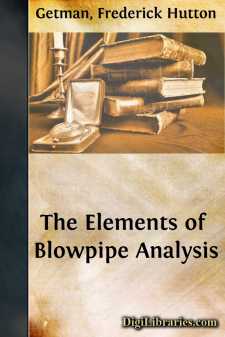Categories
- Antiques & Collectibles 13
- Architecture 36
- Art 48
- Bibles 22
- Biography & Autobiography 813
- Body, Mind & Spirit 142
- Business & Economics 28
- Children's Books 17
- Children's Fiction 14
- Computers 4
- Cooking 94
- Crafts & Hobbies 4
- Drama 346
- Education 46
- Family & Relationships 57
- Fiction 11829
- Games 19
- Gardening 17
- Health & Fitness 34
- History 1377
- House & Home 1
- Humor 147
- Juvenile Fiction 1873
- Juvenile Nonfiction 202
- Language Arts & Disciplines 88
- Law 16
- Literary Collections 686
- Literary Criticism 179
- Mathematics 13
- Medical 41
- Music 40
- Nature 179
- Non-Classifiable 1768
- Performing Arts 7
- Periodicals 1453
- Philosophy 64
- Photography 2
- Poetry 896
- Political Science 203
- Psychology 42
- Reference 154
- Religion 513
- Science 126
- Self-Help 84
- Social Science 81
- Sports & Recreation 34
- Study Aids 3
- Technology & Engineering 59
- Transportation 23
- Travel 463
- True Crime 29
The Elements of Blowpipe Analysis
Description:
Excerpt
CHAPTER I
The blowpipe was first applied to mineral analysis in 1733 by Anton Swab, and its applications have since been improved and extended by various chemists, among whom may be mentioned Bergmann, Cronstedt, Gahn, Berzelius, and Plattner.
Blowpipe.—The common blowpipe of the jeweller is not particularly well suited to the operations of blowpipe analysis, since the flame has often to be kept playing upon the assay for some time, and the condensed moisture of the breath would seriously interfere with the passage of the air through the jet. One of the best and least expensive forms of blowpipe is shown in Fig. 1. This consists, as is seen from the illustration, of a conical-shaped tube of tin closed at the wide end and formed into a mouthpiece at the small end; soldered into the tube at the large end, and at right angles to its axis, is a small brass tube which terminates in a conical tip pierced with a very fine hole. With this pipe it is possible to perform all of the operations of mineral analysis.
Some little practice is necessary to keep the flame steady and to take the breath at the same time.
No rule can well be given to the beginner, but his experience becomes his best guide.
Bunsen Flame.—Any kind of flame can be used for the blowpipe, provided it be not too small; but since almost every laboratory to-day is furnished with gas and the Bunsen burner (Fig. 2), it will only be necessary to describe the use of the flame from this source. Upon examining the Bunsen flame with care, it will be seen that the flame consists of three distinct parts.
A dark inner cone which consists of gas not yet raised to the ignition point. Beyond this there is a luminous cone, where combustion is incomplete owing to lack of oxygen, and outside of this we find the non-luminous cone where the gas is completely burned.
This outer envelope is the hottest portion of the flame, and is known as the "oxidizing" flame because there is an excess of oxygen which is imparted to substances placed therein.
The luminous cone is known as the "reducing" flame, for in it metallic oxides are reduced, the oxygen being taken up by the small incandescent particles of carbon.
If the air-holes at the base of the Bunsen burner be opened, the two inner cones become elongated, and the flame appears almost colorless.
The blowpipe enables us to get an oxidizing and a reducing flame of better form and greater power. To do this we cut off the air supply at the base of the burner and turn off the gas until the flame is about 1 cm. high; then upon introducing the blowpipe, and blowing a strong continuous jet of air across the Bunsen flame, we produce an oxidizing flame about 4-5 cm. in length. If the tip of the blowpipe be held outside of the Bunsen flame, and the pressure of the stream of air be diminished, we obtain a reducing flame.
Supports.—For supports, charcoal, platinum, and glass are chiefly used. The charcoal should be made from some light wood, such as alder. It should be well burnt, and should not scintillate or smoke....


